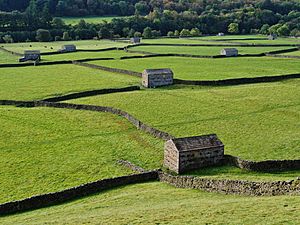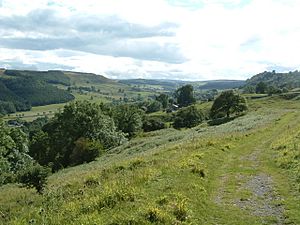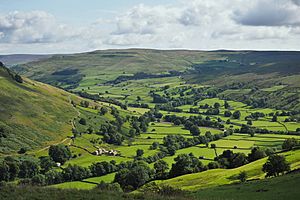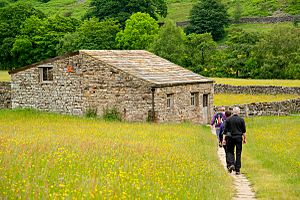Swaledale facts for kids
Swaledale is a stunning valley (also called a dale) found in the northern part of the Yorkshire Dales National Park. It's located in northern England and is named after the River Swale that flows through it. This river is on the eastern side of the Pennines mountain range in North Yorkshire.
Contents
Where is Swaledale?
Swaledale generally stretches from west to east. It starts high up on the moors near the border between Cumbria and Yorkshire. This area is a "watershed," meaning it's where rivers begin and flow in different directions. The dale then goes all the way to the market town of Richmond, where the valley opens up into flatter land.
A famous landmark called Nine Standards Rigg stands tall at the very top of Swaledale. It's a ridge with nine old stone piles called cairns. Near here, several smaller valleys like Birkdale and Little Sleddale join together to form the narrow upper part of Swaledale, starting at the small village of Keld.
From Keld, the valley briefly goes south before turning east at Thwaite. As it continues, it gets wider and passes through charming villages like Muker, Gunnerside, Low Row, Healaugh, and Reeth. The valley ends in Richmond, where an important medieval castle still stands on a cliff, watching over a historic river crossing.
Below Richmond, the valley sides become flat. The River Swale then flows across farmland until it meets the Ure near Boroughbridge. The Ure then becomes the River Ouse, which eventually joins with another river to form the Humber.
To the north of Swaledale, another valley called Arkengarthdale and its river, the Arkle Beck, join Swaledale at Reeth. To the south, you'll find Wensleydale, famous for its cheese. These two dales are separated by a ridge that includes Great Shunner Fell. You can travel between them using the road over Buttertubs Pass.
What does Swaledale look like?
Swaledale is a classic Yorkshire dale. It has a narrow road running along the valley bottom, green meadows, and fields on the hillsides. You'll see white sheep grazing and many dry stone walls that divide the land. The valley was shaped by glaciers long ago, and above the green fields, you'll see darker moorland.
The upper parts of Swaledale are especially beautiful. They have many large, old stone barns used for farming, and lots of wild flowers. These flowers grow well because farmers now wait longer to cut the grass for hay, giving the plants time to drop their seeds.
You might also spot old scars on the hillsides from lead mining that happened in the 1700s and 1800s. Ruined stone mine buildings are still there, slowly crumbling and blending into the landscape. Because of its special look, Swaledale (and Arkengarthdale) became a "Barns and Walls Conservation Area" in 1989. This means it's a protected area, and it's the largest one in the United Kingdom!
Swaledale is also home to many small but pretty waterfalls, such as Richmond Falls, Kisdon Force, and Catrake Force.
Farming and old industries
Farming sheep has always been very important to the people living in Swaledale. In fact, a special type of sheep with round horns is named after the valley: the Swaledale sheep.
In the past, people in Swaledale made wool products and Swaledale cheese. The cheese used to be made from ewe (female sheep) milk, but today it's made from cow's milk.
During the 1800s, a big industry here was lead mining. This happened in Arkengarthdale and on Grinton Moor.
Fun things to do in Swaledale today
Today, many people visit Swaledale for tourism. It's a very popular spot for walkers, especially because the famous Coast to Coast Walk trail goes right through it. Swaledale is a bit quieter than some other dales like Wensleydale, which has bigger towns and is known for its connection to the author James Herriot. Swaledale offers a more peaceful experience.
Every May and June, Swaledale hosts the two-week-long Swaledale Festival. This event celebrates small-scale music and offers many guided walks for visitors to explore the area.
In the first weekend of August, the area is home to the 'Ard Rock mountain bike festival. This event is based in Reeth and uses trails and private land in both Swaledale and Arkengarthdale.
Since 1950, Swaledale has also hosted the Scott Trial. This is a British motorcycle trials competition where riders race over a challenging off-road course of about 70 miles. It helps raise money for local charities.
You might have heard of Ravenseat, the farm belonging to Amanda Owen, also known as "The Yorkshire Shepherdess." Her farm is located in Swaledale.
Swaledale in books
The famous poet W. H. Auden once wrote in a letter in 1950 that his favorite place was "the part of the Pennines bounded on the S by Swaledale, on the N by the Roman wall and on the W by the Eden Valley." This shows how special Swaledale was to him.







